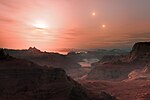HD 40307 g
Template:Planetbox begin Template:Planetbox star Template:Planetbox orbit Template:Planetbox character Template:Planetbox discovery Template:Planetbox reference Template:Planetbox end
HD 40307 g is an exoplanet orbiting in the habitable zone of HD 40307. It is located 42 light-years away in the direction of the southern constellation Pictor. The planet was discovered by the radial velocity method, using the European Southern Observatory's HARPS apparatus[1][2][3] by a team of astronomers led by Mikko Tuomi at the University of Hertfordshire and Guillem Anglada-Escude of the University of Goettingen, Germany.[3]
Composition theories
The codiscoverer Hugh Jones, of the University of Hertfordshire in England, surmised: "The longer orbit of the new planet means that its climate and atmosphere may be just right to support life." [2]
However, another astronomer, Rory Barnes of the University of Washington, had already studied the orbits of the planets b, c, and d. First, Barnes had presumed b to take on too much tidal heating for it to be terrestrial, instead predicting a "mini-Neptune". He thought that b, c, and d had all migrated inward,[4] which extrapolates to e and f as well, which are further out, but not by much. It is possible that HD 40307 g has also migrated into where it is now. The discoverers of HD 40307 g did not try to refute Barnes, on the nature of b and its extrapolation to the other planets. The composition of g is unsettled.[5] Lead author Mikko Tuomi, also of the University of Hertfordshire, stated "If I had to guess, I would say 50-50 ... But the truth at the moment is that we simply do not know whether the planet is a large Earth or a small, warm Neptune without a solid surface."[2]
See also
- Circumstellar habitable zone
- Extrasolar planet
- List of potentially habitable exoplanets
- Planetary habitability
References
- ^ Tuomi, Mikko; Anglada-Escude, Guillem; Gerlach, Enrico; Jones, Hugh R. R.; Reiners, Ansgar; Rivera, Eugenio J.; Vogt, Steven S.; Butler, R. Paul (2012). "Habitable-zone super-Earth candidate in a six-planet system around the K2.5V star HD 40307". arXiv:1211.1617v1 [astro-ph].
- ^ a b c Wall, Mike (November 7, 2012). "'Super-Earth' Alien Planet May Be Habitable for Life". Space.com. Retrieved November 8, 2012.
- ^ a b Tate, Karl (November 7, 2012). "Super-Earth Planet: Potentially Habitable Alien World Explained (Infographic)". Space.com. Retrieved November 8, 2012. Cite error: The named reference "Space-20121107b" was defined multiple times with different content (see the help page).
- ^ Barnes, R.; Jackson, B.; Raymond, S.; West, A.; Greenberg, R. (2009). "The HD 40307 Planetary System: Super-Earths or Mini-Neptunes?". The Astrophysical Journal. 695 (2): 1006. arXiv:0901.1698. Bibcode:2009ApJ...695.1006B. doi:10.1088/0004-637X/695/2/1006.
- ^ University of Toronto astronomer Ray Jayawardhana, author of Strange New Worlds: The Search for Alien Planets and Life beyond Our Solar System. Paraphrased in Dan Vergano (November 7, 2012). "Habitable zone 'Super Earth' candidate planet detected".
{{cite journal}}: Cite journal requires|journal=(help)
External links
- "Super-Earth Discovered in Star's Habitable Zone". Exoplanets.



